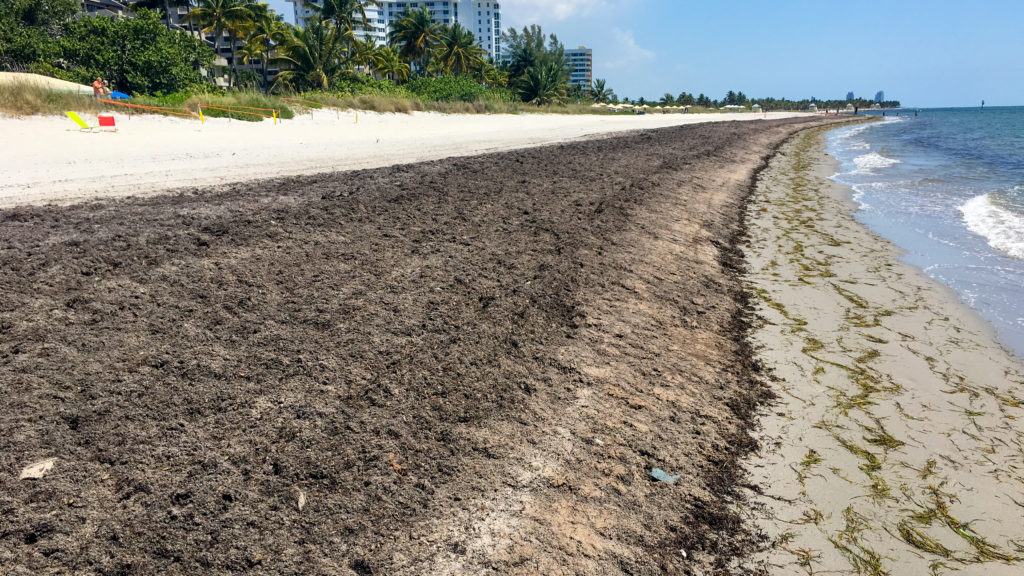Sargassum Showdown: Residents, Experts and Village At Odds Over Seaweed
Annali HaywardJune 10, 2019

Sargassum shown after being plowed into the sand on Key Biscayne, with plastic visible, June 4, 2019 (Key News/Annali Hayward)
Residents, officials, and some naturalists clashed this week over what to do about massive deposits of seaweed on island beaches. The sargassum, many say, is at its worst in years.
A petition to stop ‘dozing’ the sargassum (burying it in the sand) and instead pick it up gained almost 1,000 signatures in six days, while other residents complained even the Village’s current schedule of twice-daily burying is not enough when large quantities wash ashore.
Meanwhile, a packed house of 80 guests at the Biscayne Nature Center heard Monday from local environmental experts and activists that dozing may create a breeding ground for more bacteria to pollute the waters.
Miami Waterkeeper, a clean water group, suggested raised bacterial levels it recorded last summer may well have been linked to the decomposing matter buried in the sand.
Not only that, but the machinery used is shredding existing trash and plastics caught in the sargassum, according to Manny Rionda from the local beach cleaning movement Fill-A-Bag.
“We don’t like seaweed on our beach – it ruins our property values – I get it,” said Rionda, “so what we have instead is a layer of plastic on our beach.”
That contention is disputed by Village Public Works Director Jake Ozyman, who says he has “not seen any factual data.” as proof.
The naturally-occurring algae usually blooms in its namesake, the Sargasso Sea, in the Atlantic Ocean. Scientists believe increased runoff of nutrients from large rivers like the Mississippi and the Amazon combine with higher ocean temperatures to make for sargassum growth.
“Last year was the worst I have ever seen,” says Shane French, whose family has been taking care of South Florida’s beaches for 34 years. Miami Waterkeeper says it expects just as bad a year this year – if not more.
Ozyman said he receives half-dozen resident complaints per day when it’s bad. The Village contracts French’s employer, Beach Raker, to doze twice daily during those times.
French says burial generates immense heat in the sand, speeding up decomposition and making for an effective way of dealing with larger deposits — for now. Ozyman agrees, citing a report done for the Village several years ago by Coastal Systems Inc., a specialist engineering firm, which at the time found it to be the best option.
He said “the Village is always open to discussions” on the matter, but officials would need to see factual data that burial is harmful and to consider other methods.
Solutions
The solutions discussed at the panel event, hosted by the CLEO Institute Miami, included having a “boom” or net offshore to collect the excess growth from the water; collecting it from the beaches (and possibly composting or even finding a way to eat it), or just continuing to bury the material.
Miami Waterkeeper advised against collection from the water, stating this would affect the marine life therein. They favor leaving it to dry out, but in places where it must be removed (such as in front of hotels) they recommend picking it up for composting rather than burying it.
Composting is a popular environmentally-friendly solution, but logistics and financing for it are unclear.
In fact, says French, the cost of getting just one bulldozer on to the beach – without manpower and other considerations – is around $1,000. He estimates 20-30 would be required on a bad day with the sargassum several feet deep.
“Who’s going to pay for that? And then where do you put it?” he asked.
From an ecological perspective, the idea of removal was contested by Elizabeth Yerian, ocean naturalist at the Biscayne Nature Center. “Why don’t we just leave it alone? We have bigger fish to fry,” said Yerian, explaining removal of the sargassum can contribute to beach erosion and potentially remove a source of protection — and food — for hatchling sea turtles once they reach the water.
One thing all parties agree on is there are no easy answers.
Clearly, said Laura Chaibongsai, Program Director at MWK, “We as a community have to work out a solution together.”
Village Manager Andrea Agha is due to give an update on beach conditions in her report at Tuesday’s regular Village Council meeting, including on the contract for Beach Raker.


